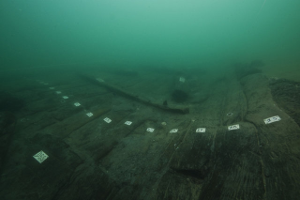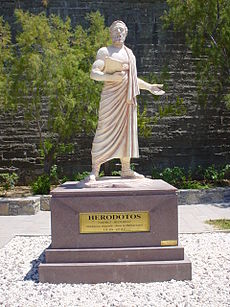|
Herodotus Boat Description Corroborated 2,500 Years Later
March 21, 2019
Archaeologists say that a recent underwater discovery solves a mystery of Ancient Egypt. The discovery is that of a baris, a barge mentioned in a famous ancient text but, until now, not discovered. Egyptians would have used a baris to ship fish and other goods along the Nile. It would have plied the waters of the Nile 2,500 years ago, archaeologists said. The barge, labeled "ship17," is between 87 and 92 feet long and is one of several dozen wrecks found in the port area of Thonic-Heracleion, in the Nile Delta region. The city was a major trading port for centuries but sunk into the Mediterranean 1,200 years ago. Marine archaeologists rediscovered it in 1999. The Greek historian Herodotus wrote about this exact kind of ship centuries ago, in his Histories; and historians have debated its existence for many years since. The more archaeologists investigated the newly found wreck, the more they found evidence to corroborate Herodotus's description. In particular, Herodotus mentioned that the ship was built using smaller pieces of wood to hold together thick planks. Discoveries before this had not turned up anything matching that description. Yet the recently discovered wreck, of which 70 percent of the crescent-shaped hull is intact, has just that sort of construction. Another part of Herodotus's description mentioned that the ship was built like brickwork, lined with papyrus, and steered by a rudder passing through a hole in the keel. Again, that is exactly what archaeologists found in this most recent wreck. Publishing the findings of the excavation is Oxford University's centre for maritime archaeology. Herodotus's full quote from Histories:
|
|
Social Studies for Kids
copyright 2002–2024
David White




 The vessels used in Egypt for the transport of merchandise are made of the Acantha (Thorn), a tree which in its growth is very like the Cyrenaic lotus, and from which there exudes a gum. They cut a quantity of planks about two cubits in length from this tree, and then proceed to their ship-building, arranging the planks like bricks, and attaching them by ties to a number of long stakes or poles till the hull is complete, when they lay the cross-planks on the top from side to side. They give the boats no ribs, but caulk the seams with papyrus on the inside. Each has a single rudder, which is driven straight through the keel. The mast is a piece of acantha-wood, and the sails are made of papyrus. These boats cannot make way against the current unless there is a brisk breeze; they are, therefore, towed up-stream from the shore: down-stream they are managed as follows. There is a raft belonging to each, made of the wood of the tamarisk, fastened together with a wattling of reeds; and also a stone bored through the middle about two talents in weight. The raft is fastened to the vessel by a rope, and allowed to float down the stream in front, while the stone is attached by another rope astern.
The result is that the raft, hurried forward by the current, goes rapidly down the river, and drags the "baris" (for so they call this sort of boat) after it; while the stone, which is pulled along in the wake of the vessel, and lies deep in the water, keeps the boat straight. There are a vast number of these vessels in Egypt, and some of them are of many thousand talents' burthen.
The vessels used in Egypt for the transport of merchandise are made of the Acantha (Thorn), a tree which in its growth is very like the Cyrenaic lotus, and from which there exudes a gum. They cut a quantity of planks about two cubits in length from this tree, and then proceed to their ship-building, arranging the planks like bricks, and attaching them by ties to a number of long stakes or poles till the hull is complete, when they lay the cross-planks on the top from side to side. They give the boats no ribs, but caulk the seams with papyrus on the inside. Each has a single rudder, which is driven straight through the keel. The mast is a piece of acantha-wood, and the sails are made of papyrus. These boats cannot make way against the current unless there is a brisk breeze; they are, therefore, towed up-stream from the shore: down-stream they are managed as follows. There is a raft belonging to each, made of the wood of the tamarisk, fastened together with a wattling of reeds; and also a stone bored through the middle about two talents in weight. The raft is fastened to the vessel by a rope, and allowed to float down the stream in front, while the stone is attached by another rope astern.
The result is that the raft, hurried forward by the current, goes rapidly down the river, and drags the "baris" (for so they call this sort of boat) after it; while the stone, which is pulled along in the wake of the vessel, and lies deep in the water, keeps the boat straight. There are a vast number of these vessels in Egypt, and some of them are of many thousand talents' burthen.

